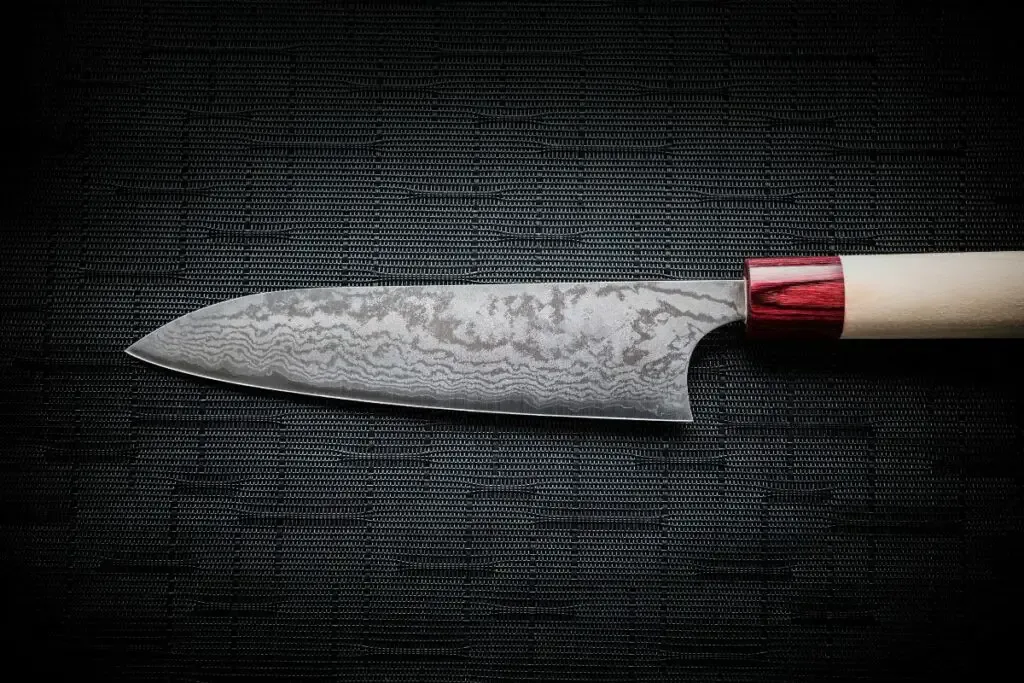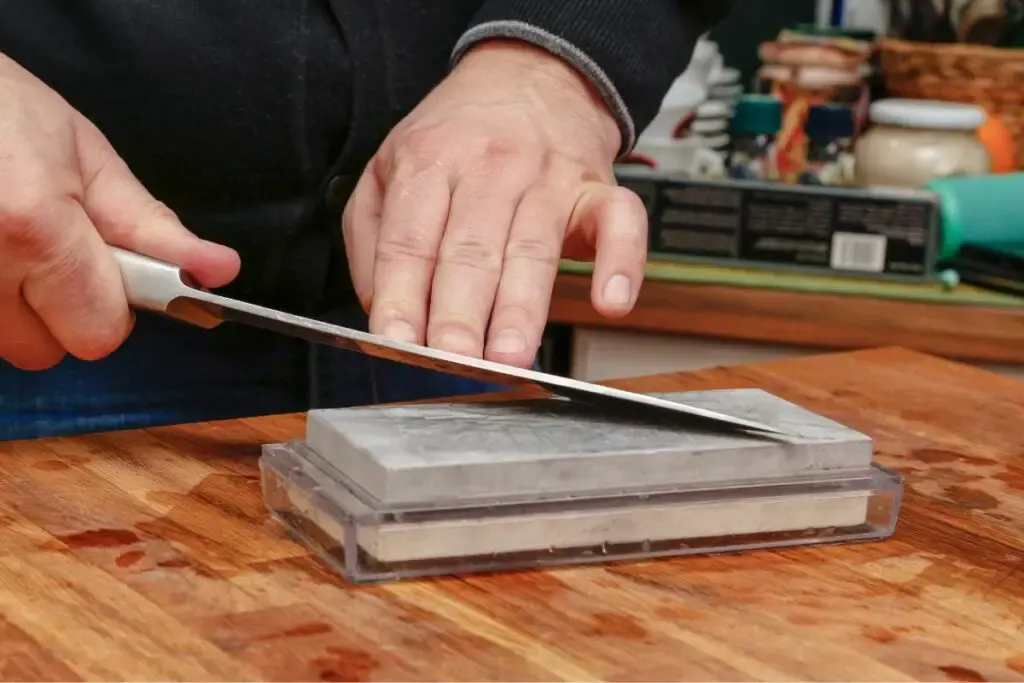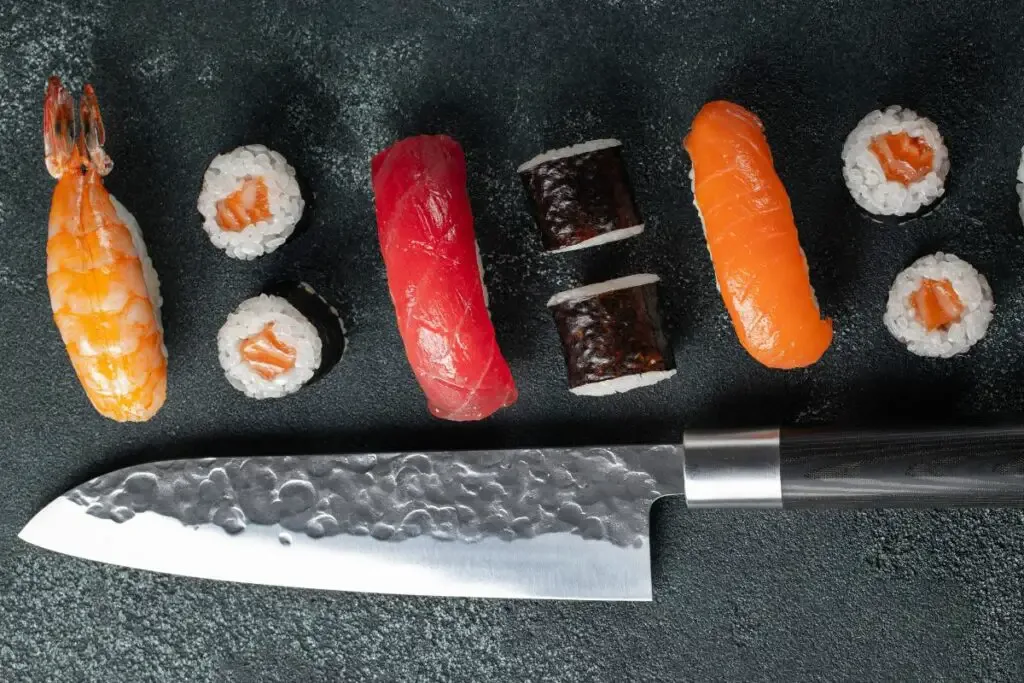As an Amazon Associate, we earn from qualifying purchases with no additional costs for you.
One of the characteristics of Japanese steel that makes great knives is the hardness of the steel. The hardness allows the steel to hold an edge very well but comes at a price. Hard steel is brittle, so impacts or torsion on the edge can chip the blade’s cutting edge. Here is how you can address the chips on the edge of your Japanese knife.
To fix a chip in a Japanese knife, you should perform the following steps.
- Establish the severity of the chip.
- Select an appropriate grit whetstone to reshape the edge.
- Work up through finer grit whetstones to re-establish the keen edge.
- Polish the edge with a finishing stone.
Many knife maintenance services offer chip repair as one of their services. This can be quite costly because the chip repair can take a fair amount of time, depending on how bad the chip is. It is possible to remove the chips from your knife as a DIY process.
If you are interested in checking out the best Japanese knives (made by Hayate Yoshihiro) we recommend and use, you can find them by clicking here (Amazon link).

Why Do Japanese Knives Chip?
Many new Japanese knife owners are unaware of the special care required for the maintenance and use of these knives. This lack of care and understanding of how Japanese knives are made leads to misuse of these knives and the cutting edge becoming chipped.
When the cutting edge of a Japanese knife sustains chip damage, it is not a manufacturing fault in the knife’s construction but rather an accident or incorrect use of the knife.
Japanese steel has a chemical composition, allowing the steel to be hardened to much higher levels of hardness than most steels produced in the Western world.
This has been a characteristic of Japanese steel for centuries, and steel with these properties is only mined and produced in Japan.
The steel can be hardened to a level of hardness above 60-HRC on the Rockwell hardness scale, while most Western steel achieves up to 58-HRC.
The hardness of the steel allows for an extremely sharp edge, and the steel holds the edge well, but the hardness comes with a compromise in flexibility.
The hardness of the steel allows Japanese knives to be thinner and lighter, and sharper than most equivalent Western kitchen knives.
The sharp cutting edge of a Japanese knife is hard but also brittle, making it susceptible to chipping if used incorrectly.
Now that we have gained a broader understanding of the nature of the steel in a Japanese knife and what causes it to chip, what can you do if your knife edge sustains chip damage?
Can You Fix A Chipped Japanese Knife?

Whether a chip on the cutting edge of a Japanese knife can be fixed will depend on the seriousness of the damage and how deep into the edge the chip extends.
The smaller the chip in the knife’s edge, the easier the chip will be to repair. If the chip is large, it may have been caused by a heavy impact on the knife’s edge, and the blade may have sustained more serious damage to the steel than a chip.
In cases of bad chips resulting from severe impacts, the steel at the apex of the chip could have become cracked.
In this instance, repairing the chip will not repair the crack, and the knife will be dangerous to use in this condition. A knife in this condition is basically a write-off and will need to be replaced.
Small chips can be fixed fairly easily and with little change to the knife, but serious chips may require more aggressive repair work, which could alter the shape and appearance of the knife.
If these repairs would be so dramatic as to affect the knife’s functionality for its intended role in the kitchen, you may need to consider replacing the chipped knife with a new knife.
TIP: The best way to sharpen a knife is using a whetstone. Do you know how long you should sharpen a knife on a whetstone? Find out the answer in the article below:
Exactly How Long Do You Sharpen A Knife On A Whetstone?
How To Fix A Chipped Japanese Knife?
If you are attempting to repair a chipped edge on your Japanese knife yourself, you need to be aware of the skills needed to perform this task.
The best way to remove chips from the blade is by using whetstones. The use of whetstones is a skill that requires practice and time to master.
If you are going to take on the task of chip repair on the knife’s edge, you should be proficient at sharpening knives on whetstones before attempting this kind of repair work.
You need to have the muscle memory and skill to maintain correct angles across the length of the knife across the stone.
Besides chipping the edge of your Japanese knife, one of the quickest ways to destroy your knife is by incorrect sharpening.
If you are not proficient in this skill, it would be better not to attempt a chip repair until you have gained some sharpening experience with whetstones.
There are two main methods to fixing the chipped edge of the knife.
- Sharpening the knife. Sharpening the knife will remove minor chips from the knife’s edge.
- Reprofiling the knife. This is a more aggressive form of sharpening the knife, which removes a lot of steel and can alter the shape of the knife.
The two methods use the same techniques but with more aggressive whetstone grits for the reprofiling of the blade.
1. Establish The Severity Of The Chip.
The process to repair the chip will start with establishing how bad the chip is on the blade. The severity of the chip will determine how aggressively you approach the repair.
The extent of the repair will determine the grit of the stone that you start with and the steepness of the angle with which you will begin the repair process.
2. Select An Appropriate Grit Whetstone To Reshape The Edge.
The grit level of the stone you will use to repair the edge of your knife depends on how deep the chip extends into the steel of the edge of the knife.
For minor chips in the blade’s edge, select a 600-grit stone to start the repair process. This is a slightly more aggressive grit than you would choose for a normal sharpening session on your knife. When fixing the repair, the angle of approach would be the same angle you would use when sharpening the knife.
For medium-size chips, a 400-grit whetstone is more appropriate for removing more material faster and repairing the edge quicker. The angle you would use to quickly remove steel to get the chip out of the edge would be a 25 to 30-degree angle on this stone.
For deep chips, a very aggressive whetstone such as a 120-grit or a 200-grit is more appropriate since removing the amount of material would take too long on higher grit stones. The angle of approach to repair a serious chip on the blade can be as steep as 45-degrees to work the chip out of the edge.
TIP: Are you looking to buy a new whetstone? Check out our recommendations (we personally use the first three ones):
Our PRO choice whetstones combo (Amazon links):
- Fixing stone: Whetstone SHAPTON Ceramic KUROMAKU #320
- Sharpening stone: Suehiro CERAX soaking whetstone: Medium #1000
- Finishing stone: Whetstone SHAPTON Ceramic KUROMAKU #5000
Our budget choice (Amazon link): Sharp Pebble Extra Large Sharpening Stone Set
3. Work Up Through Finer Grit Whetstones
If the chip was a minor chip, maintain the angle you would normally use for sharpening. Once the chip is no longer visibly on the knife’s edge, move up to a higher 800-grit stone to continue refining the edge. Progress to a 1000-grit stone and go all the way up to the grits you would normally use for sharpening.
For a medium-size chip, maintain the steeper angle on the 400-grit stone until the chip is almost gone. Then switch to a 600-grit stone and adjust the angle to what you would normally use to sharpen the knife. Progress on the 600-grit stone as you would for a smaller chip and complete by sharpening the knife.
For a major chip repair, keep the steep 45-degree angle throughout on the 120-grit or 200-grit stone until the size of the chip reduces to a medium-size chip. At this point, switch to a 400-grit stone and lower the angle of approach to a 25 or 30-degree angle.
Once the chip has reduced even further to the size of a small chip, progress to a 600-grit stone. Decrease the angle to a normal sharpening angle for the knife. Stay on the 600-grit stone until all signs of the chip are gone, then proceed to sharpen the knife.
4. Polish The Edge With A Finishing Stone
The final step is the same irrespective of the size of the original chip on the knife. Polish the final edge the way you would normally do after a rigorous sharpening session.
A stone of 6000-grit or higher would suffice as a finishing stone, but if you normally polish on a higher grit, then finish with that stone.
TIP: Japanese knives are, without a doubt, one of the best knives on the market. Unfortunately, many times we encounter their fakes. In the article below, you will find 8 features to watch out for in order not to buy a fake Japanese knife!
Spotting FAKE Japanese KNives: 8 Features To Watch Out For
DIY Repair vs Professional Services: Making the Right Choice

When faced with a chipped Japanese knife, owners often grapple with the decision between embarking on a DIY repair journey and seeking the help of professional services. Both options come with advantages and challenges, and the choice largely depends on the individual’s experience, the chip’s severity, and the knife’s value.
Before deciding on the repair route, it’s crucial to assess the extent of the damage. Minor chips that only affect the blade’s edge can often be addressed with a careful and well-executed DIY repair. However, more severe damages, especially those affecting the structural integrity of the knife, may necessitate professional intervention to ensure the knife is safely and effectively restored.
DIY repair is a viable option for those who have some level of proficiency with using whetstones and are familiar with the techniques of sharpening and reprofiling knives. For beginners or those unfamiliar with knife repair, attempting a DIY fix can risk further damage to the blade.
In these cases, seeking professional services guarantees expertise and reduces the risk of exacerbating the damage.
While DIY repair is generally more cost-effective, it requires an investment in quality whetstones and other tools. Professional services can be more expensive due to the labor costs involved, but they can save the owner from the costs associated with improper repair, such as the need to replace the knife entirely.
DIY repair can be time-consuming, especially for those new to the process. It requires patience, practice, and a steady hand. Professional services relieve the owner of the time and effort involved in the repair process, providing a convenient solution for those with busy schedules.
For high-value or sentimental knives, professional services offer the assurance of a skilled and experienced hand, reducing the risk of irreversible damage. While DIY repair can be rewarding, the potential for error may not be worth the risk for particularly valuable or cherished knives.
The goal is to restore the knife to its optimal functionality and preserve its longevity, so choose the option that best aligns with your needs, abilities, and the value you place on your Japanese knife.
How Do You Stop Japanese Knives From Chipping?

The best way to stop Japanese knives from chipping is to learn what causes them to chip and avoid subjecting the knife to these situations or circumstances.
The following causes are the most frequent events that result in the chipping of the sharp edge.
- Dropping the knife on a hard surface.
Dropping the knife on a hard surface such as a tiled floor, concrete floor, granite countertop, or any other hard surface can chip the edge.
- Chopping on a hard surface.
Using a hard, rigid cutting board such as one made from granite, glass, or a block of very hard wood can result in the cutting edge becoming chipped.
- Cutting into bone.
Accidentally cutting into bone while preparing meat and poultry is a common cause of chipping the knife’s blade. When the brittle edge impacts the bone, the steel cannot flex due to its rigidity and the blade chips.
- Cutting into pits.
Ingredients that can have hard pits in them, such as olives and avocados, can chip your knife’s edge if you cut into these pits with force.
- Cutting frozen foods.
Frozen food can be hard enough to cause the edge of a knife to chip. A frequent cause of knife chipping is cutting partially defrosted foods, and the center of the ingredient is still frozen solid.
- Using a twisting motion when cutting.
Japanese knives are intended for use in a straight up and down or forward and back cutting motion. Any twisting motion during the cut or at the end of a cut can chip the blade.
- Pushing ingredients across a cutting board.
Some knife users habitually push the ingredient sideways across the cutting board after the cut to move the sliced section out of the way. This is okay as long as you don’t drag the blade’s edge across the board’s surface, which can result in the blade becoming chipped.
Avoiding these situations will be an effective method of preventing chips to the cutting edge of your Japanese knife!
TIP: All Japanese knives are made for a purpose. So it is important to use them for what they were made for. Find out what not to cut with Japanese knives in the article below:
Complete List: What NOT TO CUT With Japanese Knives & Why?
BTW: If you want to know more about Japanese and other knives and their sharpening, check out the books listed above. These books are recommended by professional sharpeners and knife makers (Amazon links):
- Japanese Kitchen Knives: Essential Techniques and Recipes
- The Knifenerd Guide to Japanese Knives
- Knife: The Culture, Craft, and Cult of the Cook’s Knife
- Sharp: The Definitive Introduction to Knives, Sharpening, and Cutting Techniques, with Recipes from Great Chefs
Conclusion
Repairing chips on the edge of your Japanese kitchen knife can be done as a DIY project, provided that you have the necessary skills on a whetstone.
The main route to success with this type of repair to the edge of a Japanese knife is to take it slow and steady and not rush the job.
With a little luck and determination, your treasured Japanese knife will be back in action as sharp as ever!
TIP: The best way to keep your Japanese knives sharp is by using whetstones! If you don’t know how to choose and buy whetstones, click the article below for the ultimate buyer’s guide!
How To Choose And Buy A Whetstone: The Ultimate Buyer’s Guide
